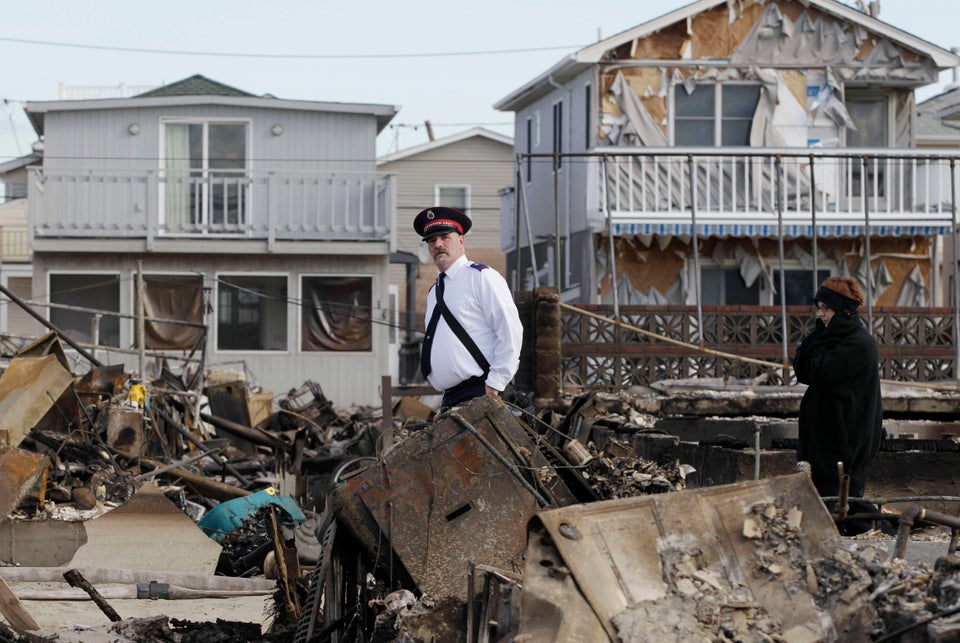
STATEN ISLAND, N.Y. -- At a time when public approval of labor unions is near an all-time low, union workers are charged with much of the dirty and dangerous work of cleaning up after Hurricane Sandy. Here, along one the hardest-hit stretches of New York waterfront, union workers fixed Internet connections, disconnected gas pipes to prevent explosions and patrolled the streets in cop cars and ambulances.
In other the storm-devastated regions of New Jersey, New York, and Connecticut, union workers are repairing and clearing roads and bridges, restoring phone service, turning the lights back on, getting the subway lines back on track, repairing homes, operating hotels where families are taking refuge from their flooded neighborhoods, and nursing injured survivors back to health. And that's to say nothing of the unionized police officers and firefighters who, as in Staten Island, seem to be stationed on every corner in zones with heavy damage.
"Once again, we’re seeing how the working people of America pull together when things get hard and their efforts save lives," said Vincent Alvarez, president of the New York City Central Labor Council.
According to a Gallup Poll from August 2012, (http://www.gallup.com/poll/157025/labor-union-approval-steady.aspx) 52 percent of Americans approve labor unions, a rate up only slightly from the all-time low of 48 percent in 2009. The wave of anti-union sentiment of the last few years has arguably had significant political consequences, most notably the arrival of the Tea Party class of Republicans in Congress two years ago and the anti-union efforts championed by the likes of Gov. Scott Walker (R) in Wisconsin and Rep. Paul Ryan (R-Wis.).
Those developments raised big questions concerning the labor force: Should workers have collective bargaining rights and paid vacation days? Do unions bolster the economy or weaken it? On Friday, people in the flood-ravaged areas seemed unconcerned about those questions. "We'd welcome anyone," said James Gafney, 32, standing outside his debris-strewn Staten Island home.
Larry Lutz, a steamfitter with Local 638 on Staten Island, was among the union workers helping the cleanup in Midland Beach, a devastated neighborhood in Staten Island. He couldn't go to his actual job on Friday -- his construction site was still underwater -- so he decided to help friends in the neighborhood where he grew up, hauling trash and damaged belongings out of basements and ground-floor apartments. "To me this is a catastrophe, and there should be more manpower," he said.
Candice Johnson, a spokeswoman for the Communication Workers of America, said unionized technicians at Verizon, AT&T, and Cablevision are working 12 hours a day, seven days a week, to restore service. The union also represents 60,000 public workers in New Jersey who are cleaning and repairing bridges and roads and taking 911 calls, she said.
In Connecticut, AT&T crews were dispatched with disaster equipment as Hurricane Sandy neared so that workers could respond quickly, Johnson added.
Union volunteers have played a big role in clearing the downed trees in eastern Queens, according to Sally Frank, campaign manager for Nily Rozic, a community leader running for state legislature. Volunteers from Local 79 and Local 1010 of the Laborers contacted Rozic shortly after the storm, Frank said, and arrived with "good spirits and saws and got to work immediately."
Many union workers are among the hardest-hit by the storm, but still worked long days. According to Jim Brown with the Long Island local International Brotherhood of Electrical Workers Union, his members "left their families, many with flooded and damaged homes, and came to work, some before before the storm hit, and have remained there working 16-hour shifts. That has left them with only eight hours to travel home, rest, cope with their own situations, and return to work again."
School was still cancelled on Friday, but Arthur Nallario, 37, and his colleagues -- teachers at a Staten Island high school and members of the United Federation Of Teachers -- were doing what they could around the battered borough. Nallario was biking through the hardest-hit waterfront areas to hand out fliers advising residents of locations for food and supplies, how to apply for FEMA funding, and letting them know about an Internet access and phone charging station that would open Monday at the high school. "I think union workers have really come together to help their communities," said Nallario, who has lived on Staten Island his entire life.
*************************
The Huffington Post is eager for insights from our community, especially people with experience in power, infrastructure and engineering, on the adequacy of emergency preparation in advance of Hurricane Sandy, and the degree to which past disasters have informed adequate planning and construction. Please send a note to sandytips@huffingtonpost.com with insights and suggestions for the important questions that need to be asked of relevant private sector and government officials, and point us toward stories that need to be pursued.
Scroll down for live blog updates.

